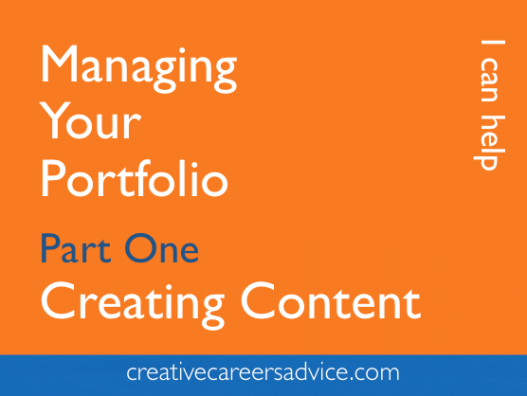1) Working Out Your Plan & Strategy
The work that you choose to showcase should be the type of work that you want to be hired to produce
Whether physical or online, your portfolio represents: your career calling card and your passport to multiple opportunities. There's nothing more important to your career than presenting your best work in an attractive, professional and accessible way.

So the decisions you make on what to include should take time and maximum effort to ensure the content, the style, tone of voice and appeal is right.
Consider:
Quality, Quantity & Breadth of Work / Appropriate examples / The context and process of your project & Case Studies / Relevance of Non-client & Experimental work / Self-promotion & About Me section / Updatable & Adaptable

"Be selective and tell different stories through your projects. When I say stories I mean objectives/briefs/category and disciplines if applicable. This will give you a breadth of projects showcasing creative problem solving. Always remember your audience when presenting and don't forget the details and take them on a journey. Never put anything in you are not proud of, I always start and finish with my favourite projects.” Leo Young | Sector: Graphic Design | Founder of Good Nugget
A portfolio is a perfect platform showing a multitude of personal skills:
- Presentation & layout - the design & overall look & feel of the portfolio
- Editorial - what you select to display
- Navigation - Access and ease of use
- Communication - Who you are what you do and how you do it
- Project Management - Include briefs and project breakdowns
2) Suggested Content
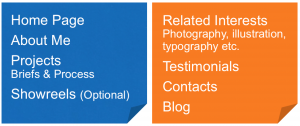
3) It's Not Just The Finished Work - Show Your 'Process'
Every project goes through a process. Some are elaborate, wonderfully creative, highly technical and delivered by a multi-skilled team. Others may be simpler, require less production & resources and are the work and skills of one person... but they all have a beginning, middle and an end:
The brief > Ideas & Concepts > Pitch & Presentation
Pre-production > Production > Post-production > Client Sign-Off > Delivery
A portfolio devoid of process lacks depth, context and meaning
Therefore, it's good to include a few key projects just showing the final work. However, simply showing the final stills, animation, app or website across the whole portfolio is not enough.
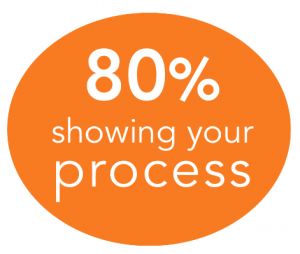
Employers want to see why and how you arrived at the solution. So I'd suggest you think about creating 80% of your projects showing your process - telling the 'back story' of your creative and technical journey.
Contextualising your work & showing your process means describing your project process using the language of the professional practice you are aligning to, whatever your specialism might be: UX/UI, Motion Design, Illustration, VFX/3D, Videographer etc.
But have less text and more pictures, pictures are the visual stimulus whilst limited but relevant text gives further meaning, context and value to the narrative
Use this simple framework and set of questions below to explain your projects and help form a narrative construct for your particular audience. Creative agencies will use a form of this framework for each project they execute.

Targeted Questions
- What is your project about? Give an outline of the brief requirements.
- How does your solution connect to the client? List a series of aims and objectives aligned to the client’s expectations.
- Who’s the target audience? Describe the customer it’s aimed at. Here you can demonstrate some marketing awareness.
- What was your role and input? Whatever the level, include specific details.
- What was your production process? If it’s branding, a video, packaging, or a mobile app etc. then put it into context, how was it achieved?
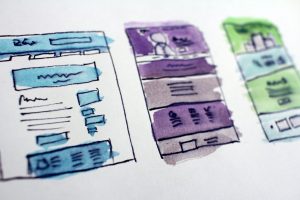
- Illustrate your creative and technical processes. Don't be afraid to show rough sketches, diagrams, storyboards, wireframes, 2D/3D sketches, greyscale animatics, test frames - whatever the medium you work in, explain how you got there - go deep, entertain, inform and inspire them, showing how you too love and understand the creative process.
“In the UX/UI world, a solid rationale is paramount! Nowadays being a good designer is not just about designing beautiful things. You need to be a problem solver, able to come up with a clear strategy to achieve your client's goals. Show me a well thought out case study that states the objectives, your creative process and solutions (together with some eye-candy visuals) and I'm already in love!”
Andrea Dona, Digital Lead at Velocity Partners & Founder of Hotline Design
Professionals want to understand how you develop ideas and manage your production process. Detail what resources you have used including technical skills. If you worked in a team to deliver the creative then say so and be clear about the role you played.
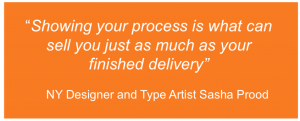
But a word of caution, don’t show all of your process if it doesn’t add to your story or relate in some way to the job roles you’re targeting. Also don’t overly repeat stuff as it will just look like padding.
Edit carefully and focus on the fundamentals that show understanding the problem and how you created the solutions that your targeted agency, creative professional can identify with. Show the projects that you can really stand behind.
You’re only as strong as your weakest link, so be selective.
Showreels If your skills and experience involve motion of any kind, then editing and including an 'animated compilation of content' is essential. Sometimes employers in these disciplines may ask you to 'send me your showreel' ahead of any possible interview. So it's an important and strategic part of your promotional toolbox.
"I remember a Post-Production Supervisor saying he hired someone to work on Troy because he saw a six second shot of an asteroid hitting Cardiff and it had realistic looking dust in it. Six seconds in a whole reel got him the job, because he could do dust and they needed dust." Jonny Elwyn, Freelance Editor
4) Self-Initiated Work Creatives want to see originality, flair and ‘left of field’ ideas, (they can get easily bored and distracted, a common trait in creative people). Self-initiated projects show your commitment and self-motivation. It also allows freedom of ideas, interests and passions that commissioned work can lack due to the client/brief restrictions.
Self initiated projects however big or small, are just as important to include, but in the right place and context in your portfolio. Maybe create a separate section in the portfolio for it, but include it!

5) Content Ownership
Ensure all your projects make it clear what you personally did:
Creatively, Technically, Strategically
If you worked with others and it was a 10% input, then define what that was. That 10% could be a valuable slice of experience on which to build and shows potential, but ensure it’s a relevant 10%.
If it was wholly your project, but you enlisted the help of an illustrator, commissioned music, asked a developer to help built the backend of your app or someone edited your video… celebrate the collaboration and credit them.
90% of the time in these creative roles - you will be working within or alongside teams and individuals, whether they contribute to the creative, technical, marketing or project management side. There’s no role that's exclusively solo - even as a freelancer.
Being able to engage, coordinate and work with people is having that all-important skill - teamwork. Every interview will include the question: “Give an example of when you worked in a team on a project?” So define your involvement in each project, and have a think why they ask you that question...
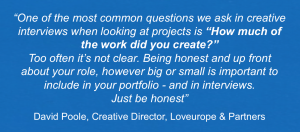
6) Non Specific Work
Think of non-specific but relatable experiences you’ve had - if strategic then include them. For example, having photographic skills means they are relatable directly to some disciplines: 3D & VFX, film direction, editing, videography. And indirectly to others - all involving visual communication.
 Conclusions
Conclusions
Employers want to understand:
- How you approach challenges and solutions??
- How you, your skills and portfolio of work can fit into their world
- What you have to offer them and what are the returns on their investment in you?
- But remember… also think - what they can offer you?
Use your portfolio as an opportunity to brag…
There's nothing more important to your career than presenting your best work in an attractive, professional and accessible way.
- Design your portfolio & brand it
- Show your personality & identity
- Let the work speak for itself
- Create a narrative thread
- Speak your audience’s language
- Quality over quantity
- Be honest in every detail
- Show process, process, process
- Tailor the portfolio to specific audiences
- Select the right format(s)
- Demonstrate confidence through your work
All photographs in this blog are courtesy of: Unsplash - https://unsplash.com/
© Paul Butler is a Creative Careers Adviser, Design Director and HE Lecturer in employability and Creative Industry careers.
For one-to-one creative careers advice and coaching contact me at: paulb@creativecareersadvice.com
If you found this blog useful share it with your contacts and follow me for more posts on creative careers advice and employability topics.
Related articles: Confidence In Public Speaking / Pitch & Presentation / How To Build Effective Client Relationships & Cope with Feedback / Becoming A Great Public Speaker
Why not sign up for membership of Tern Heads: https://ternheads.com/
A creative community of peers and professionals, dedicated to entry-level talent. We offer a network of accessible opportunities and a space to showcase your work to potential employers.
